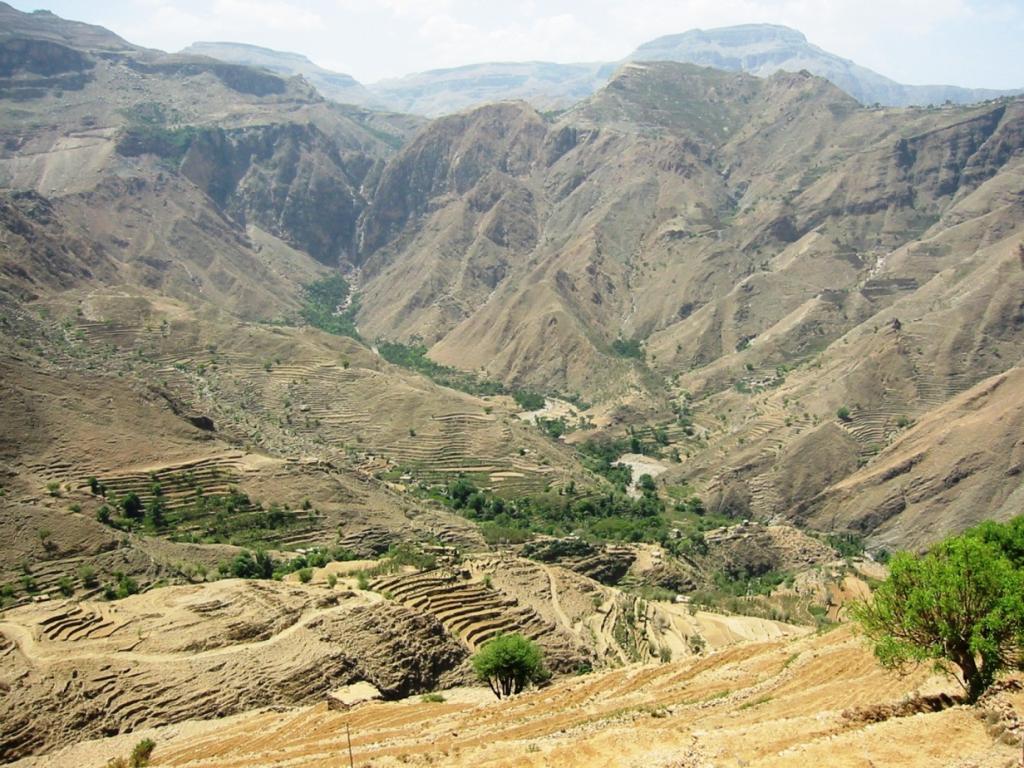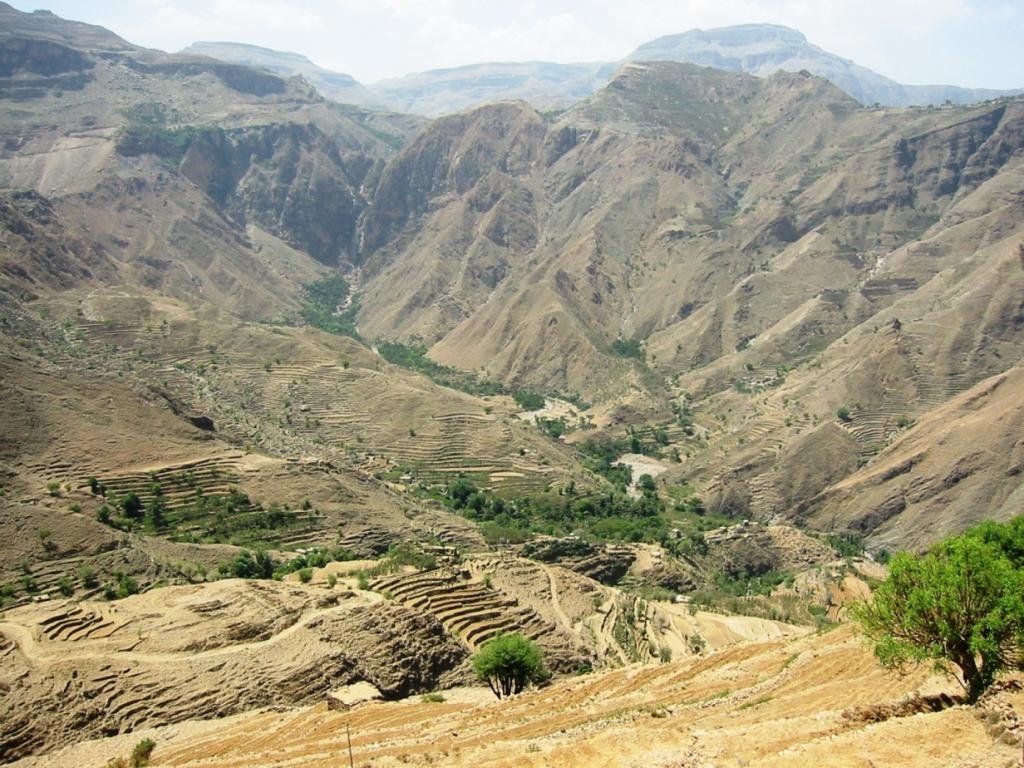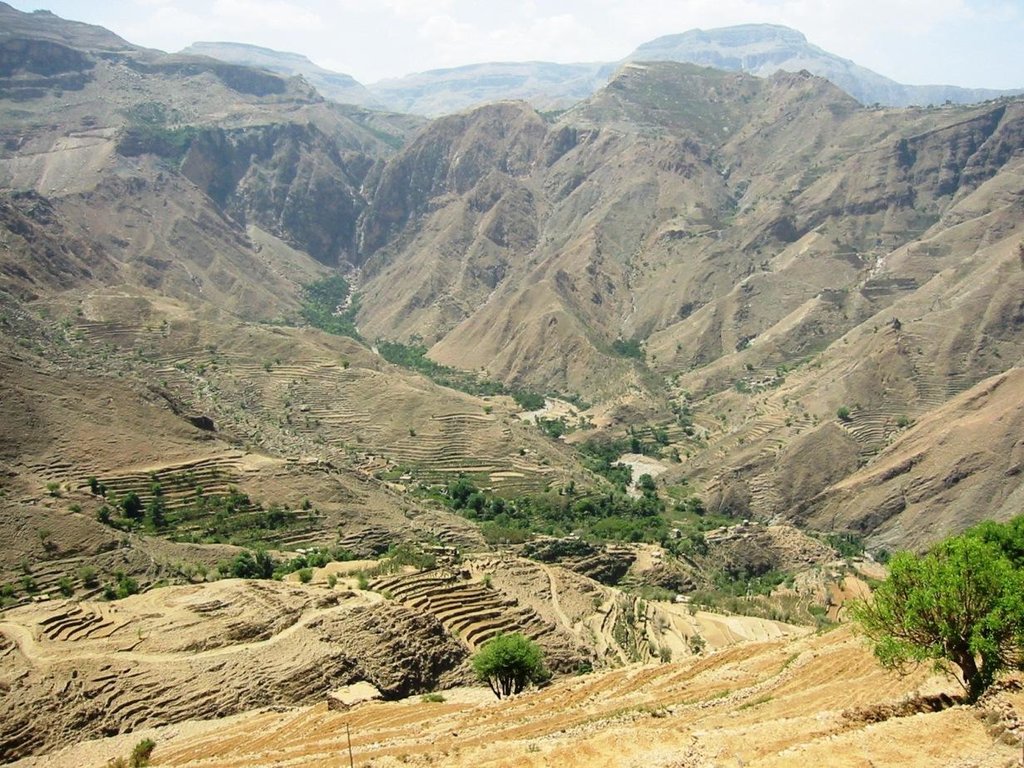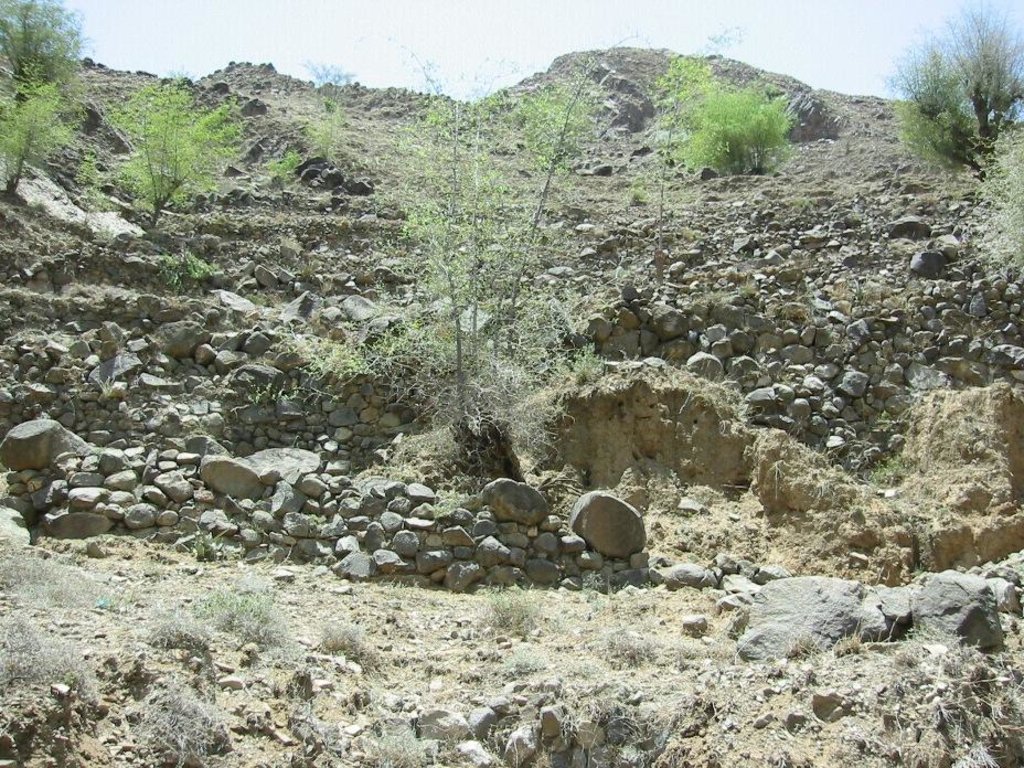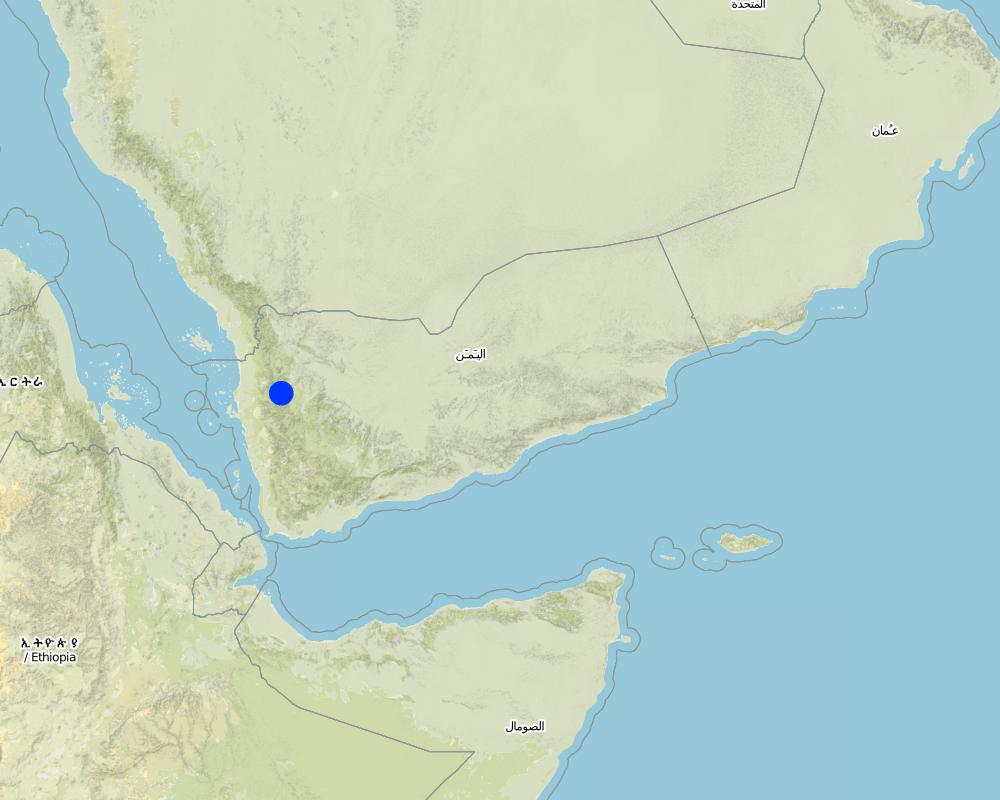leveled mountain terraces [Yemen]
- Creación:
- Actualización:
- Compilador: ahmed algalal
- Editor: –
- Revisor: Fabian Ottiger
المدرجات الجبلية المستوية
approaches_2621 - Yemen
Visualizar secciones
Expandir todo Colapsar todos1. Información general
1.2 Detalles de contacto de las personas de referencia e instituciones involucradas en la evaluación y la documentación del Enfoque
Especialista MST:
Almashreki Mohammed
mashreki2000@yahoo.com
Agricultural Research and Extension Authority, AREA
Yemen
Nombre de la(s) institución(es) que facilitaron la documentación/ evaluación del Enfoque si fuera relevante)
Agricultural Research and Extension Authority (AREA) - Yemen1.3 Condiciones referidas al uso de datos documentados mediante WOCAT
¿Cuándo se compilaron los datos (en el campo)?
09/02/2013
El compilador y la/s persona(s) de referencia claves aceptan las condiciones acerca del uso de los datos documentados mediante WOCAT :
Sí
1.4 Referencia/s al/los Cuestionario(s) de Tecnologías MST
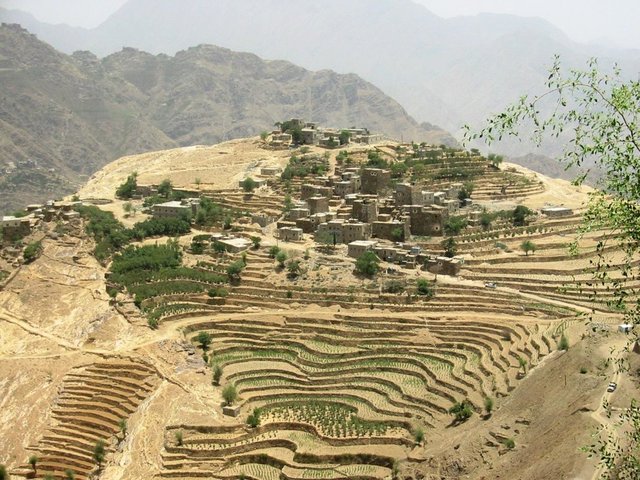
Flat Contour Terraces [Yemen]
Old flat terraces were built in accordance with the contour lines and surrounded by stones to create a suitable environment for the growth of crops, slope stabilization and reduce the risk of runoff and increasing water harvesting.
- Compilador: ahmed algalal
2. Descripción del Enfoque MST
2.1 Breve descripción del Enfoque
organized collective action at a high pace for building agricultural terraces to improve livelihoods in resource-scarce regions in the ground
2.2 Descripción detallada del Enfoque MST
Descripción detallada del Enfoque MST:
Aims / objectives: A lot of agricultural land in mountain plains are mountain terraces were established in Yemen a long time ago and which constitute a method agriculturally traditionally unique since 2000 BC where it was built in steep slope places more than 60%, which works to change the shape of the slope (angle and length of the slope), which in turn leads to reduced Speed runoff, which helps to harvest water and protect the land from erosion.
The main objective of the establishment of the stands is to create a suitable environment for the growth of crops for the purpose of self-sufficiency due to a limited of arable land where invoked farmers veterans to create these terraces on the hillsides steep in order to increase the agricultural area and benefit from the runoff water to meet the crop water requirements and thereby increase productivity , in addition to the tower the terraces is working to change the shape of the slope and mitigate the damage resulting from the runoff, on the one hand.
Other works on the terraces to give a special character of beauty and greenery on the slopes and planted joy and hope in the hearts of the people and enhance their adherence to this tradition as long as shares in the stability and meet the needs of the population.
Terraces were built by the community in which concerted action all classes for the construction of terraced disease extraction of soil and collect stones and the end of the settlement of the soil and planting
2.3 Fotos del Enfoque
2.5 País/ región/ lugares donde el Enfoque fue aplicado
País:
Yemen
Región/ Estado/ Provincia:
Hajah Governorate
Especifique más el lugar :
Kahlan Afar
Map
×2.7 Tipo de Enfoque
- tradicional/ local
2.8 Propósitos/ objetivos principales del Enfoque
The Approach focused mainly on SLM with other activities (Increase the agricultural area, water harvesting, increasing the productivity of the crop)
Creating a suitable environment for the growth of crops, prevent soil loss, minimize the risk resulting from the rapid runoff, water harvesting and increase soil moisture
The SLM Approach addressed the following problems: the lack of arable land, the soil water erosion, poverty
2.9 Condiciones que facilitan o impiden la implementación de la/s Tecnología/s aplicadas bajo el Enfoque
disponibilidad/ acceso a recursos y servicios financieros
- impiden
lack of money
Treatment through the SLM Approach: use of available resources in the region
marco de trabajo legal (tenencia de tierra, derechos de uso de tierra y agua)
- facilitan
The existing land ownership, land use rights / water rights greatly helped the approach implementation: did not occurs raised to the implementation process because the bleachers at the foundation and found out of nowhere and work on community-created en masse, however, has been the work of legislation to regulate the process and maintenance of irrigation terraces
- impiden
Water Rights
Treatment through the SLM Approach: Documentation of an agreement between the land users on the method of water distribution and irrigation priority so that it is the first former regime from top to bottom
carga de trabajo, disponibilidad de mano de obra
- impiden
Lack of labor
Treatment through the SLM Approach: work collectively at all stages of the implementation of the technology
3. Participación y roles de las partes interesadas involucradas
3.1 Partes interesadas involucradas en el Enfoque y sus roles
- usuarios locales de tierras/ comunidades locales
All local community. Approach includes all parts of society, because the person who created the stands is all members of society without exception
Men have more experience and ability to work. Women do works that are commensurate with their ability
3.2 Involucramiento de los usuarios locales de tierras/ comunidades locales en las distintas fases del Enfoque
| Involucramiento de los usuarios locales de tierras/ comunidades locales | Especifique quién se involucró y describa las actividades | |
|---|---|---|
| iniciación/ motivación | ninguno | |
| planificación | ninguno | |
| implementación | ninguno | |
| monitoreo y evaluación | ninguno | |
| Research | ninguno |
3.4 La toma de decisiones en la selección de Tecnología(s) MST
Especifique quién decidió la selección de las Tecnología/ Tecnologías a implementarse:
- solamente usuarios de tierras (autoiniciativa)
Explique:
It is originally an ancient technique and exist but need to be rebuilt
Decisions on the method of implementing the SLM Technology were made by by land users* alone (self-initiative / bottom-up)
4. Apoyo técnico, fortalecimiento institucional y gestión del conocimiento
4.1 Construcción de capacidades / capacitación
¿Se proporcionó la capacitación a usuarios de tierras/ otras partes interesadas?
No
4.3 Fortalecimiento institucional (desarrollo institucional)
¿Se establecieron o fortalecieron instituciones mediante el Enfoque?
- no
4.4 Monitoreo y evaluación
¿El monitoreo y la evaluación forman parte del Enfoque?
Sí
Comentarios:
bio-physical aspects were ad hoc monitored by land users through observations; indicators: wise and dignitaries with the correct mind.
technical aspects were ad hoc monitored by land users through measurements; indicators: wise and dignitaries with the correct mind.
socio-cultural aspects were regular monitored by land users through measurements
economic / production aspects were ad hoc monitored by land users through observations
no. of land users involved aspects were regular monitored by other through measurements
management of Approach aspects were regular monitored by other through measurements
There were no changes in the Approach as a result of monitoring and evaluation
There were no changes in the Technology as a result of monitoring and evaluation
4.5 Investigación
¿La investigación formó parte del Enfoque?
No
5. Financiamiento y apoyo material externo
5.1 Presupuesto anual para el componente MST del Enfoque
Si no se conoce el presupuesto anual preciso, indique el rango:
- 2,000-10,000
Comentarios (ej. fuentes principales de financiamiento/ donantes principales):
Approach costs were met by the following donors: local community / land user(s) (Local community): 100.0%
5.4 Crédito
¿Se proporcionó crédito bajo el Enfoque para actividades MST?
No
6. Análisis de impacto y comentarios de conclusión
6.1 Impactos del Enfoque
¿El Enfoque ayudó a los usuarios de tierras a implementar y mantener Tecnologías MST?
- No
- Sí, un poco
- Sí, moderadamente
- Sí, mucho
teamwork is one of the most important elements of sustainable land and protect it from deterioration and this the approach, which followed by the old farmers even continued the stands terraces to this day.
Did other land users / projects adopt the Approach?
- No
- Sí, un poco
- Sí, moderadamente
- Sí, mucho
Did the Approach lead to improved livelihoods / human well-being?
- No
- Sí, un poco
- Sí, moderadamente
- Sí, mucho
Did the Approach help to alleviate poverty?
- No
- Sí, un poco
- Sí, moderadamente
- Sí, mucho
The increase in the agricultural area, water harvesting areof the most essential ingredients to alleviate poverty.
6.2 Motivación principal del usuario de la tierra para implementar MST
- producción incrementada
Increase the amount of production
- conciencia medioambiental
- The creation of new agricultural land
- Stability and improve the people's livelihood
6.3 Sostenibilidad de las actividades del Enfoque
¿Pueden los usuarios de tierras sostener lo que se implementó mediante el Enfoque (sin apoyo externo)?
- sí
Si respondió que sí, describa cómo:
Terraces built without support and continued to the present day
6.4 Fortalezas/ ventajas del Enfoque
| Fuerzas/ ventajas/ oportunidades desde la perspectiva del compilador o de otra persona de referencia clave |
|---|
| Improve the livelihoods and the stability of society (How to sustain/ enhance this strength: Continuing to maintenance operations) |
| A tributary of real teamwork in advancing progress and achieve the desired goal, namely, agricultural terraces and teamwork lead to the strengthening of the social fabric and the bonds of love and assistance among themselves (How to sustain/ enhance this strength: Community awareness and land users in particular, the importance of the continuation of collective action to ensure the sustainability and continuity of the stands that need to unite everyone to preserve them for future generations.) |
| Take advantage of all the resources available in the region in the process of construction of terraces traditional methods and in accordance with the natural conditions and topography of the region |
7. Referencias y vínculos
7.1 Métodos/ fuentes de información
- visitas de campo, encuestas de campo
- entrevistas con usuarios de tierras
7.2 Referencias a publicaciones disponibles
Título, autor, año, ISBN:
Report of the environmental resources available in the Afar region Kahlan (Mashreki, 2003)A study of land degradation in the Republic of Yemen (Yemen - ACSAD, 2002
¿Dónde se halla disponible? ¿Costo?
Agricultural Research and Extension Authority, AREAAgricultural Research and Extension Authority, AREA
Título, autor, año, ISBN:
A study of land degradation in the Republic of Yemen (Yemen - ACSAD, 2002)
¿Dónde se halla disponible? ¿Costo?
Agricultural Research and Extension Authority, AREA
Vínculos y módulos
Expandir todo Colapsar todosVínculos

Flat Contour Terraces [Yemen]
Old flat terraces were built in accordance with the contour lines and surrounded by stones to create a suitable environment for the growth of crops, slope stabilization and reduce the risk of runoff and increasing water harvesting.
- Compilador: ahmed algalal
Módulos
No se hallaron módulos


